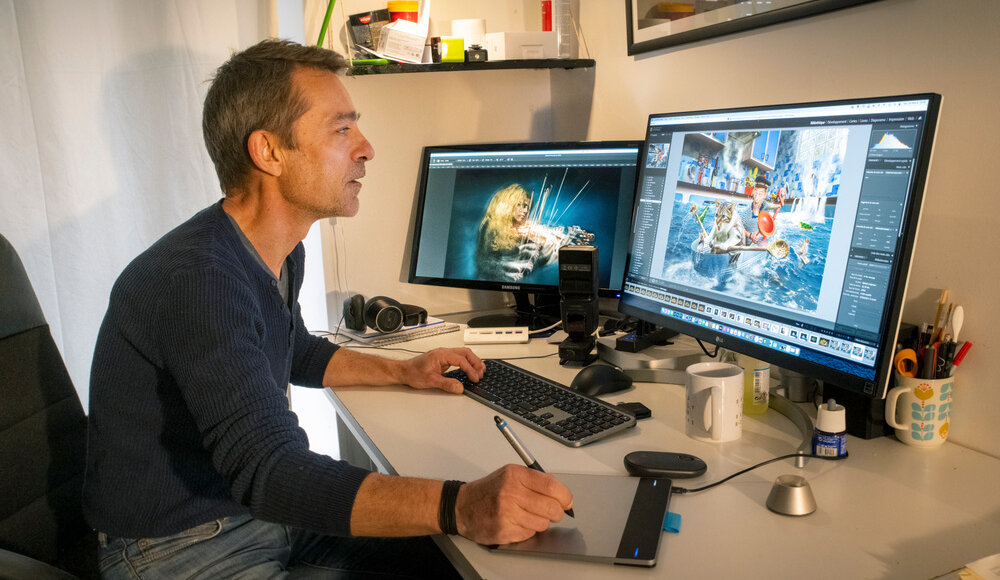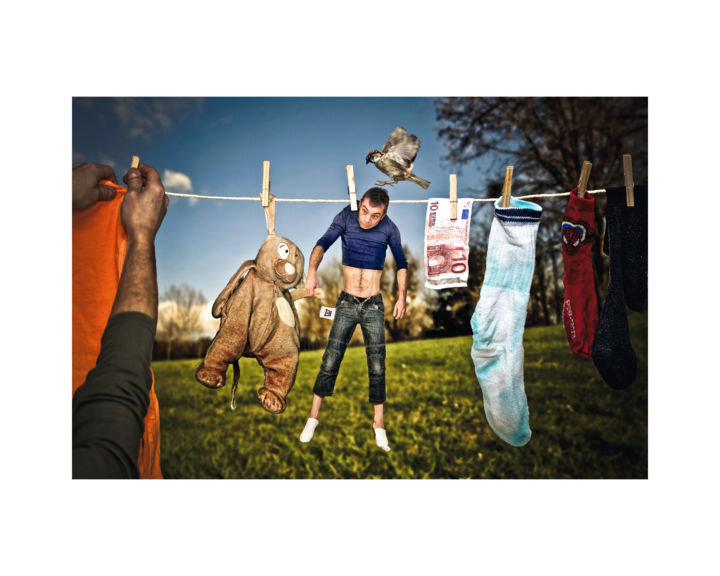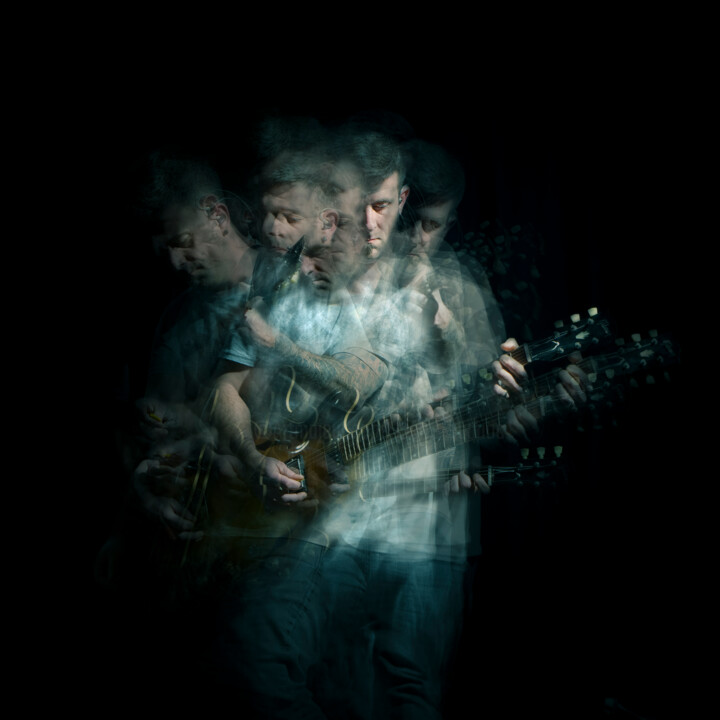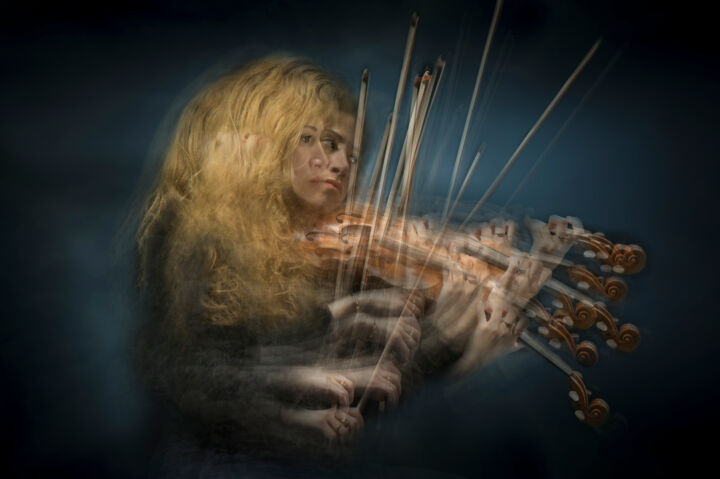What inspired you to create works of art and to become an artist? (events, feelings, experiences...)
The desire, or rather, the need and surely also this kind of immense freedom, of a big white sheet that is offered to you, and on which no one comes to tell you "you are going to do this" or "you are going to do that ".
It's a bit difficult to explain.
I have always been attracted by the possibilities offered by digital tools to modify an image or to create one from others. It must go back to my childhood, when my eyes were glued to the movie screen where my parents took me to see the very first Star Wars.
I thought to myself “these guys are crazy, what they can do with cameras, screens and all these new techniques, it's great! ".
Unfortunately, I didn't make it my main job, but many years later, when the first computers for individuals came out, I rushed, and even more so when digital cameras became democratized.
Today, my equipment has evolved a lot, but I am still imbued with the first sensations of the kid that I was, and who drank in humorous comic strips, traces of which can be found in my series “Les Minipéripéties”.
What is your artistic background, the techniques and subjects you have experimented with so far?
I am totally self-taught and I did not follow any artistic course.
Photography is not my main profession (which has absolutely nothing artistic about it).
But I got into it more seriously after my divorce, about fifteen years ago, when I started the “Mini adventures” series.
I expanded my material, watched multiple tutorials on the internet to better master Photoshop, made a lot of mistakes and finally… learned a lot from others, which I still do.
I make photomontages, but also more "conventional" photographs, always with a digital camera, then depending on the desired result, few or many hours on the computer to obtain the exact vision of what I have. on your mind.
What are the 3 aspects that differentiate you from other artists, making your work unique?
It's quite difficult to determine, and somewhat vain!
By making an effort, I would say that in the first place, I don't try to draw inspiration from the work of other artists, even well-known ones. Some will certainly see some similarities between my works and those of other creators. When this is true, it is purely fortuitous and not researched (I have discovered certain artists this way!).
The two series on which I am currently working (“Les Minipéripéties” and “Ghosts”) are thus devoid of any conscious reference to existing works, which is why, I think, they are unique.
Secondly, I always try in these creations to recreate my intimate worlds.
This can only make my works unique, since no one but me wanders through my mind (at least I hope so!).
Finally, photography is not my main job, so I have complete freedom over the meaning of my works, their aesthetics and I am not constrained by time or money to produce them.
Where does your inspiration come from?
When I take “conventional” photos, of the moment, the place and the state of mind in which I am.
When I work on retouched photos or photomontage, my experience (divorce) and my reflections on the passage of time (work on memory).
What is your artistic approach? What visions, sensations or feelings do you want to evoke in the viewer?
For the series of "Mini adventures", it was a question of recounting with humor and self-mockery the life of a recently divorced father and confronted with the immensity of household chores.
Playing with pixels then turned out to be the only way to reduce the father in question and install him in the huge theater that was the new apartment.
This allows me a hesitant narration between a dreamlike, disproportionate, sometimes disturbing world, and a real world, with amplified constraints.
I discovered in fact in this new situation, an amusing paradox between a world around me which was shrinking (the circle of friends, the finances, the accommodation, the outings, even the wounded spirit which withdraws into itself -even), and this other world where the scale of the chores dilated this “small” apartment when it was necessary to take care only of the meals, the dishes, the linen, the cleaning, the do-it-yourself… The size ratio changed.
Staged, with a few visual transformations, the original situation did not implicitly invite a smile, so it was necessary to make sure to put this shambles into perspective by using humorous photographic writing playing on the absurd.
My apartment has thus become a giant and absurd circus, my intimate universe has become collective, because in the end, everyone dreams of leaving dirty dishes and cleaning in the care of a magical elf.
Regarding the “Ghosts” series, I chose to work on the theme of disappearances.
Not the most painful, such as the loss of a loved one, but rather those that I would call the small daily disappearances, those moments that our brain captures, stores in our memory, in order to then be able to transform them as it pleases, in this what we call our memories.
I felt that the movements of artists, musicians, dancers, singers, circus artists and others are particularly conducive to this little game.
They fade away little by little behind their instruments, their performances, in favor of the traces they will leave in our memory, and the memories that our unconscious will produce.
At the end of the show, their small disappearance helps us to populate, to haunt our minds.
What is the process of creating your works? Spontaneous or with a long preparatory process (technical, inspiration from art classics or other)?
For the “Mini adventures” series, I see the photo in my mind and I only start working when it is perfectly clear. It is then a question of recreating the scene and the preparatory process can be relatively long.
For the “Ghosts” series, I'm more instantaneous. It's seeing the musician on stage that everything starts. I don't have to recreate a whole theatre, it's already before my eyes, it's already starting to disappear, and I just have to continue this process by working with the multiple shots taken.
Do you use a particular working technique? if so, can you explain it?
I use photomontage techniques a lot, but they are not an end in themselves.
I consider that doing photomontage is only interesting when this technique makes it possible to tell a story, to transmit a universe or a feeling.
I'm also working on a technique of stacking perfectly clean shots, playing on the transparencies to achieve an impression of blur. I then enhance the details that marked my mind with small touches. This is the technique I use for the “Ghosts” series. I find that it translates perfectly the way in which our memory works, by successions of transformations in time.
Are there any innovative aspects in your work? Can you tell us which ones?
I don't know if humor can be considered innovative in art, but in any case it is not very widespread.
It is quite present in several of my works. It is a trait that can also serve me. I have the impression that humor has a lot of trouble being accepted in artistic creation, that you are not taken seriously when you sprinkle it on your works, that it is not "academic" in sum.
But I persist and sign, if we don't laugh during our lifetime, we won't do it afterwards! And why not do it also in art?
Do you have a format or medium that you are most comfortable with? if yes, why ?
No. I stay in the classic photo formats. They are in themselves an ideal window for my creations.
Where do you produce your works? At home, in a shared workshop or in your own workshop? And in this space, how do you organize your creative work?
For the shots, it all depends on the series. Very often during classical music concerts, and for the series of "Mini adventures", of course my home serves as a theater.
I also do the post-production work at home.
Does your work lead you to travel to meet new collectors, for fairs or exhibitions? If so, what does it bring you?
Sometimes I take part in exhibitions, fairs or festivals in France.
Well before the exchanges with the professionals, it is above all the feedback from visitors that enriches me the most. My best reward is a smile or a burst of laughter from a visitor planted in front of one of my creations!
These events are, in my opinion, the best places to publicize his work and gather criticism, whether good or bad.
How do you imagine the evolution of your work and your career as an artist in the future?
It must be another trait of my personality, and of the freedom that I mentioned earlier, but I don't plan anything!
For now, I'm working on my two main series. I let them live, and surely die, on their own.
I am confident that other inspirations will come to ensure the continuation. Time will tell !
What is the theme, style or technique of your latest artistic production?
I recently made a series of 15 creations for the Maison de l'environnement of a community of communes in Ile de France.
I had total carte blanche to work on the notion of waste.
Against the current of everything that we had seen on this subject, I chose to erase from our sight the waste of everyday life. We never talk about the subject as much as when it is not there!
Starting from the premise that we are so used to the presence of waste that, in short, we (almost) no longer see it. So I recreated everyday scenes where all the packaging or waste in the making, in the short or medium term, disappears and only the content is visible.
For this, I used photomontage and 3D modeling techniques.
Focused on the various gestures of the daily life of a household, the series does not have a critical or moralizing sense on our habits, but simply proposes to invite reflection on the notions of production, treatment and recycling of waste (can we recycle everything, under what conditions, at what financial and environmental costs, indefinitely?).
Finally, it carries with it the idea that the best of our waste is that which does not exist.
Can you tell us about your most important exhibition experience?
I have two. My very first exhibition ten years ago, I was still only an amateur!
And then my participation in the Mac Paris show in Paris in 2019.
This was my first “pro” exhibition. I was discovering a new atmosphere, and for a week, I was able to interact with professionals, artists and visitors.
It opened a few doors for me, allowed several sales, everything was unexpected for me.
Not to mention that I enjoyed working with a team of passionate, friendly organizers who really work in an activist way for artists. It was a great introduction!
If you could have created a famous work in the history of art, which one would you choose? And why ?
The “Dali atomicus” by photographer Philippe Halsman.
Because it's a photo, and he managed to freeze an extraordinary movement that fit perfectly with Dali's surrealism. I always believed that he had created an assembly with the techniques of the time.
Well no, it was all done in one take, and that leaves the photomontage fan that I am dreaming!
If you could invite one famous artist (dead or alive) to dinner, who would it be? How would you suggest he spend the evening?
Leonardo da Vinci.
Ok, he's not a photographer, but I'm sure he could have been, or even invented photography if he had been born a few centuries later.
He was a jack-of-all-trades genius, a visionary.
I will offer him to go back in time, and make me discover his workshops, his plans, his techniques. And perhaps also to reveal to me the secret of the enigmatic and bewitching smile of his Mona Lisa!









 Olimpia Gaia Martinelli
Olimpia Gaia Martinelli












